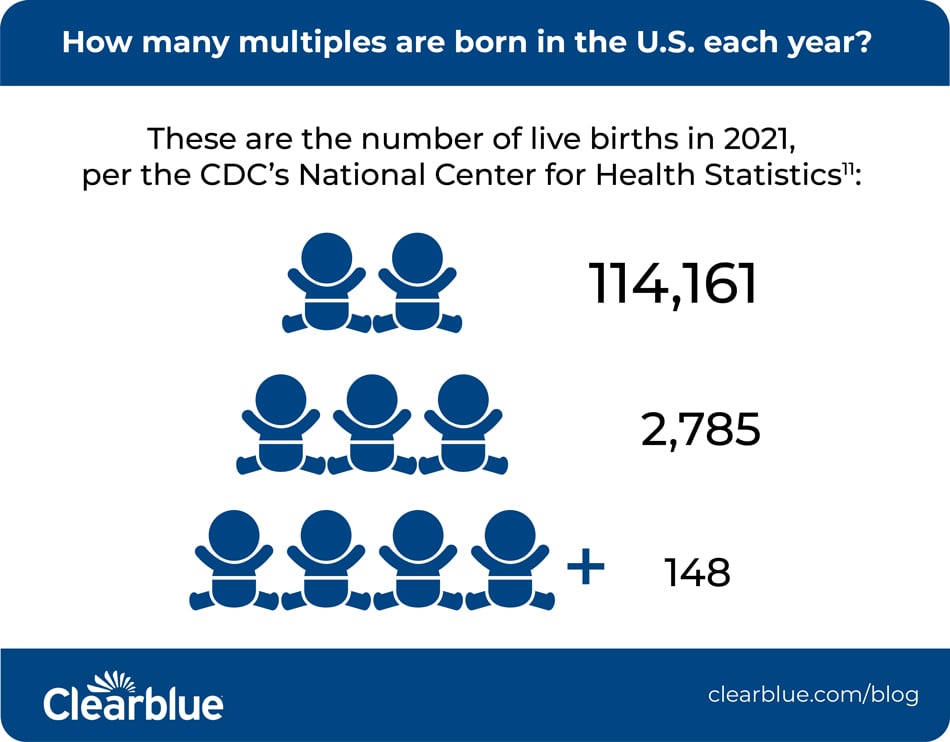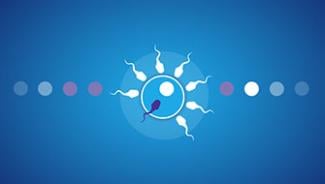The chances of having twins: What can cause a multiple pregnancy?

Whether you’re hoping for twins or are just curious, you may wonder about the likelihood of getting pregnant with multiples. Maybe you’ve heard that fertility drugs and age can be factors, but also genetics and even your height. What’s true and what’s not? Let’s find out.
Do some people have a higher chance of having twins?
Yes! There are some factors that can increase your chances of having twins. But honestly? Most are completely out of your control. You have a higher likelihood of having twins if:
- You’re using fertility drugs: You’re more likely to release more than one egg from the ovary, resulting in a multiple pregnancy.1 We dig into this in more detail below!
- You’re undergoing in vitro fertilization (IVF) or other forms of Assisted Reproductive Technology (ART): If more than one embryo is transferred to the uterus there is an increased chance of a multiple pregnancy.1
- Your family members have had multiples: If you have relatives who have had fraternal twins, you have an increased chance of having fraternal twins, too. We explore this more below!2
- You’re over the age of 30, especially 35 or older:1-3 According to The American College of Obstetricians and Gynecologists (ACOG), if you’re over the age of 35 you are more likely to release two or more eggs during a menstrual cycle.1
- You are Black or white: According to March of Dimes, Black people are more likely to have twins2 and white people older than 35 are most likely to have triplets or more.2,4
- You’ve been pregnant before: Your chances for a multiple pregnancy increase if you’ve been pregnant in the past and are even higher if you’ve been pregnant with multiples before.3,4
- You have a higher body mass index (BMI) or you’re tall (possibly): According to March of Dimes, if you have a BMI of 30 or higher, you’re more likely to have twins.2 (According to the Centers for Disease Control (CDC), BMI of 18.5 to 24.9 is considered a healthy weight, and a BMI of 25.0 to 29.9 is considered overweight. A BMI of 30 or higher is considered obese. You can calculate your BMI using this tool from the Centers for Disease Control. An old study published in 2005 looked at more than 51,000 live births between 1959 and 1966 and compared how often twinning births occurred with a pre- pregnant BMI of more than 30 and (to a lesser extent) height as factors that may increase the chance of having fraternal twins.5 Additionally, the American Society for Reproductive Medicine (ASRM) says fraternal twins are more common in taller people with higher BMIs, but for reasons that may have more to do with nutrition, noting that during World War II, the number of fraternal twins decreased in Europe due to food scarcity.3
- You consume a lot of dairy or you’re not vegan (possibly): A study published in Nature in 2006 showed that vegans were five times less likely to have twins and stated that the study’s author proposed that eating dairy products could increase your chances of having twins.6 More research is needed.
Are twins hereditary?
The short answer? Sometimes.7,8 Whether genetics truly play a role in having multiples has yet to be determined definitively.7,8 According to the March of Dimes, if you have family members who have had fraternal twins, you may be more likely to have fraternal twins.2 In fact, if a close relative (such as a sibling) has fraternal twins, you are two times more likely to have fraternal twins.8
And what if you are a twin? According to ASRM, fraternal twin females give birth to twins at a rate of one set per 60 births, and fraternal twin males father twins at a rate of one set per 125 births.3 Also, twins do not skip a generation — that’s a myth.7
A quick note about fraternal twins vs. identical twins: Fraternal twins, who won’t resemble each other any more than regular siblings, occur when more than one egg is released from the ovary, each egg is fertilized by a sperm and two separate embryos implant in the uterus.1 Identical twins, who will look very similar, be the same sex, have the same blood type and share eye and hair color, occur when a single fertilized egg splits and the resulting embryos are identical.1 It is more common to have fraternal twins than identical twins.1
Can you increase your chances of having twins?
Technically, you can wait to try to conceive (TTC) until you’re older but that can be a risky move. Fertility begins to decline around age 30, which can make getting pregnant more difficult.9
Additionally, while fertility drugs and treatments do come with an increased chance of having twins, they are prescribed for reasons related to infertility, not to increase the chance of having twins. Still, if you’re undergoing treatment for infertility, you may be wondering how much your chances increase depending on the type of treatment.
According to information published in 2012 by ASRM, 5% to 12% of people who take clomiphene citrate (such as Clomid) will have twins, and about 30% of people who use gonadotropins (injected hormones to trigger ovulation) will have twins.3 As of 2020, the CDC reports that the percentage of twins as a result of assisted reproductive technology (ART) such as IVF has decreased in recent years, from 26.8% in 2011 to 6.4% in 2020.10
How many multiples are born in the U.S. each year?
As reported by the CDC’s National Center for Health Statistics, 114,161 sets of twins were born in 2021.11 Triplets and higher multiple births were far rarer: 2,785 sets of triplets and 148 sets of quadruplets or higher were born in that same year.11

Having twins, like many variables related to pregnancy, isn’t really within your control. When TTC, there is not much, if anything, you can do to guarantee a multiple pregnancy. But you can educate yourself to give you and your future baby (or babies!) the best path forward.
Related Articles
Sources
- The American College of Obstetricians and Gynecologists. Multiple pregnancy. Updated February 2021. Accessed March 6, 2023. https://www.acog.org/womens-health/faqs/multiple- pregnancy
- March of Dimes. Being pregnant with twins, triplets and other multiples. Updated June 2021. Accessed March 6, 2023. https://www.marchofdimes.org/find-support/topics/pregnancy/being- pregnant-twins-triplets-and-other-multiples
- American Society for Reproductive Medicine. Multiple pregnancy and birth: twins, triples, and high order multiples. Updated 2021. Accessed March 6, 2023. https://www.reproductivefacts.org/news-and-publications/patient-fact-sheets-and-%20booklets/documents/fact-sheets-and-info-booklets/multiple-pregnancy-and-birth-twins-triplets-%20and-high-order-multiples-booklet/
- University of Rochester Medical Center. Overview of multiple pregnancy. Accessed March 6, 2023. https://www.urmc.rochester.edu/encyclopedia/content.aspx?contenttypeid=85&contentid=P0 8019
- Reddy UM, Branum AM, Klebanoff MA. Relationship of maternal body mass index and height to twinning. Obstet Gynecol. 2005;105(3):593-597. doi:10.1097/01.AOG.0000153491.09525.dd. Accessed March 6, 2023. https://pubmed.ncbi.nlm.nih.gov/15738030/
- Pearson, H. A diet of milk could bring twins. Nature. 2006. doi:10.1038/news060515-19. Accessed March 6, 2023. https://www.nature.com/news/2006/060515/full/news060515-19.html
- WebMD. Do twins run in families? What to know about the heredity of twins. Updated July 23, 2022. Accessed March 6, 2023. https://www.webmd.com/parenting/do-twins-run-in-families-what-to-know-heredity-twins
- A.D.A.M. Is the probability of having twins determined by genetics? Accessed March 6, 2023. https://medlineplus.gov/genetics/understanding/traits/twins/
- The American College of Obstetricians and Gynecologists. Having a baby after age 35: How aging affects fertility and pregnancy. Updated February 2023. Accessed March 6, 2023. https://www.acog.org/womens-health/faqs/having-a-baby-after-age-35-how-aging-affects- fertility-and-pregnancy
- Centers for Disease Control and Prevention. 2020 assisted reproductive technology fertility clinic and national summary report. Accessed March 6, 2023. https://www.cdc.gov/art/reports/2020/pdf/Report-ART-Fertility-Clinic-National-Summary-H.pdf
- Centers for Disease Control and Prevention, National Center for Health Statistics. Multiple births. Updated April 24, 2023. Accessed May 29, 2023. https://www.cdc.gov/nchs/fastats/multiple.htm

When is the best time to get pregnant?
There are only a few days each cycle, around ovulation, when a woman is fertile. Knowing these days can maximise your chance of conceiving.

Get pregnant naturally
Ovulation tests are accurate and simple to use.




